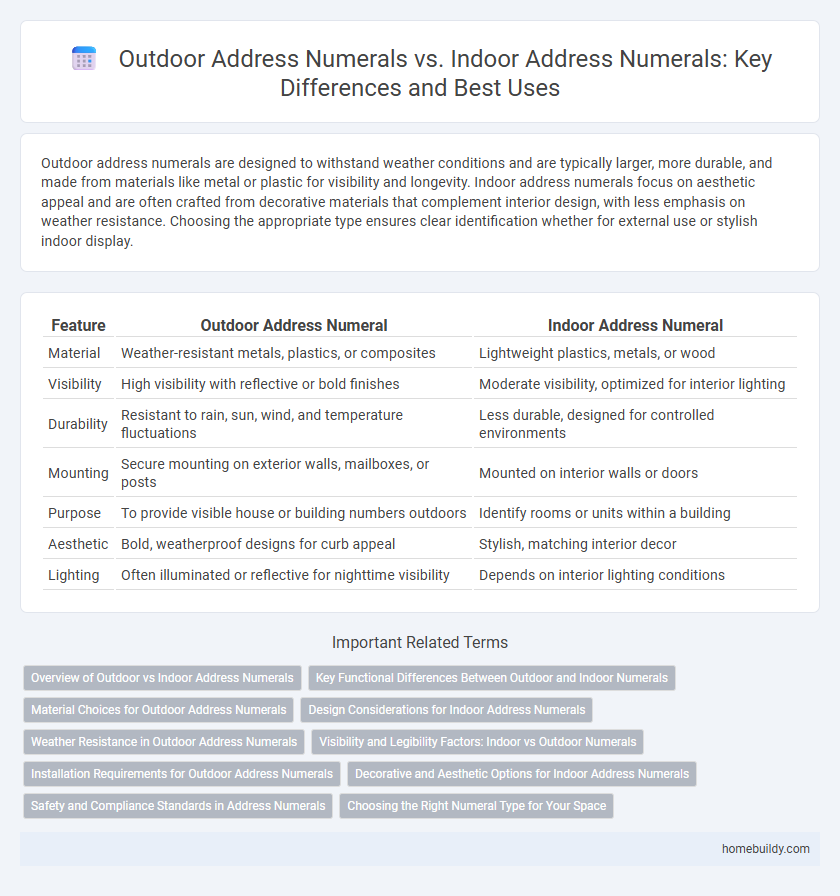Outdoor address numerals are designed to withstand weather conditions and are typically larger, more durable, and made from materials like metal or plastic for visibility and longevity. Indoor address numerals focus on aesthetic appeal and are often crafted from decorative materials that complement interior design, with less emphasis on weather resistance. Choosing the appropriate type ensures clear identification whether for external use or stylish indoor display.
Table of Comparison
| Feature | Outdoor Address Numeral | Indoor Address Numeral |
|---|---|---|
| Material | Weather-resistant metals, plastics, or composites | Lightweight plastics, metals, or wood |
| Visibility | High visibility with reflective or bold finishes | Moderate visibility, optimized for interior lighting |
| Durability | Resistant to rain, sun, wind, and temperature fluctuations | Less durable, designed for controlled environments |
| Mounting | Secure mounting on exterior walls, mailboxes, or posts | Mounted on interior walls or doors |
| Purpose | To provide visible house or building numbers outdoors | Identify rooms or units within a building |
| Aesthetic | Bold, weatherproof designs for curb appeal | Stylish, matching interior decor |
| Lighting | Often illuminated or reflective for nighttime visibility | Depends on interior lighting conditions |
Overview of Outdoor vs Indoor Address Numerals
Outdoor address numerals are designed to be weather-resistant, often made from durable materials like metal or heavy-duty plastic to withstand rain, sun, and wind. Indoor address numerals prioritize aesthetic appeal with more delicate materials and designs since they do not face harsh environmental conditions. Both types vary in size and visibility, with outdoor numerals typically larger and more reflective to ensure clear visibility from the street.
Key Functional Differences Between Outdoor and Indoor Numerals
Outdoor address numerals are specifically designed with weather-resistant materials such as aluminum, stainless steel, or heavy-duty plastic to withstand exposure to rain, sun, and temperature fluctuations, whereas indoor numerals prioritize aesthetics and are often made from lighter, decorative materials like acrylic or wood. Visibility features including reflective coatings or backlighting are common in outdoor numerals to ensure readability from a distance and during nighttime, while indoor numerals focus on style and integration with interior design elements. Mounting methods also differ, with outdoor numerals using robust, weatherproof fasteners to secure to exterior surfaces, contrasting with indoor numerals that often utilize adhesive backing or simpler mounting hardware suitable for indoor use.
Material Choices for Outdoor Address Numerals
Outdoor address numerals require durable materials such as stainless steel, aluminum, or weather-resistant plastics to withstand exposure to rain, UV rays, and temperature fluctuations. Powder-coated metal provides corrosion resistance and maintains color vibrancy over time, while acrylic options offer lightweight durability and resistance to fading. Selecting materials with high durability and weather resistance ensures visibility and longevity of outdoor address numerals.
Design Considerations for Indoor Address Numerals
Indoor address numerals prioritize aesthetics and readability within controlled lighting, often utilizing materials like brushed metal or acrylic with matte finishes to reduce glare. Design considerations include size proportional to typical viewing distances, font style clarity, and integration with interior decor to enhance visibility without overpowering the space. Unlike outdoor numerals, indoor address markers can incorporate subtle backlighting or artistic elements, as environmental durability is less critical.
Weather Resistance in Outdoor Address Numerals
Outdoor address numerals require superior weather resistance to withstand elements like rain, wind, UV rays, and temperature fluctuations, ensuring long-lasting visibility and durability. Materials such as stainless steel, brass, or weatherproof plastics are commonly used for outdoor numerals due to their corrosion resistance and ability to maintain color integrity over time. Indoor address numerals do not face harsh weather challenges, allowing for more versatile material options focused on aesthetic appeal rather than durability.
Visibility and Legibility Factors: Indoor vs Outdoor Numerals
Outdoor address numerals feature weather-resistant materials and high-contrast finishes designed to withstand elements and ensure visibility from a distance in varying lighting conditions. Indoor numerals prioritize sleek design and subtlety, often using less reflective surfaces that enhance legibility up close without glare. Factors such as size, font style, and illumination dramatically influence the visibility and legibility of numerals in both indoor and outdoor settings.
Installation Requirements for Outdoor Address Numerals
Outdoor address numerals require weather-resistant materials such as metal, acrylic, or high-grade plastic to withstand elements like rain, wind, and UV exposure. Installation typically involves secure mounting on exterior walls or posts with corrosion-proof screws and anchors to ensure durability and visibility. Proper placement at eye level and clear from obstructions is essential for emergency responders and visitors to identify the address promptly.
Decorative and Aesthetic Options for Indoor Address Numerals
Indoor address numerals offer a wide range of decorative and aesthetic options, including customizable fonts, colors, and materials such as brushed metal, wood, or acrylic to complement interior design themes. These numerals can be illuminated with LED backlighting or integrated into stylish plaques to enhance visibility and add ambiance. Unlike outdoor address numerals, indoor versions prioritize artistic expression and coordination with home decor elements to create a visually appealing and cohesive environment.
Safety and Compliance Standards in Address Numerals
Outdoor address numerals must comply with visibility and durability standards, ensuring they are weather-resistant and easily readable in low-light conditions to enhance emergency response and safety. Indoor address numerals prioritize fire safety regulations, often requiring non-flammable materials and proper placement for quick identification by occupants and first responders. Both indoor and outdoor numerals follow strict compliance codes set by local authorities to maintain clear property identification and support efficient emergency navigation.
Choosing the Right Numeral Type for Your Space
Outdoor address numerals are designed with weather-resistant materials like stainless steel, brass, or UV-treated plastics to withstand rain, sun, and temperature fluctuations, ensuring long-lasting visibility. Indoor address numerals prioritize aesthetic appeal and often use lighter materials such as acrylic or wood, emphasizing style over durability. Selecting the right numeral type depends on exposure to elements, visibility requirements, and design preferences for your specific location.
Outdoor address numeral vs indoor address numeral Infographic

 homebuildy.com
homebuildy.com